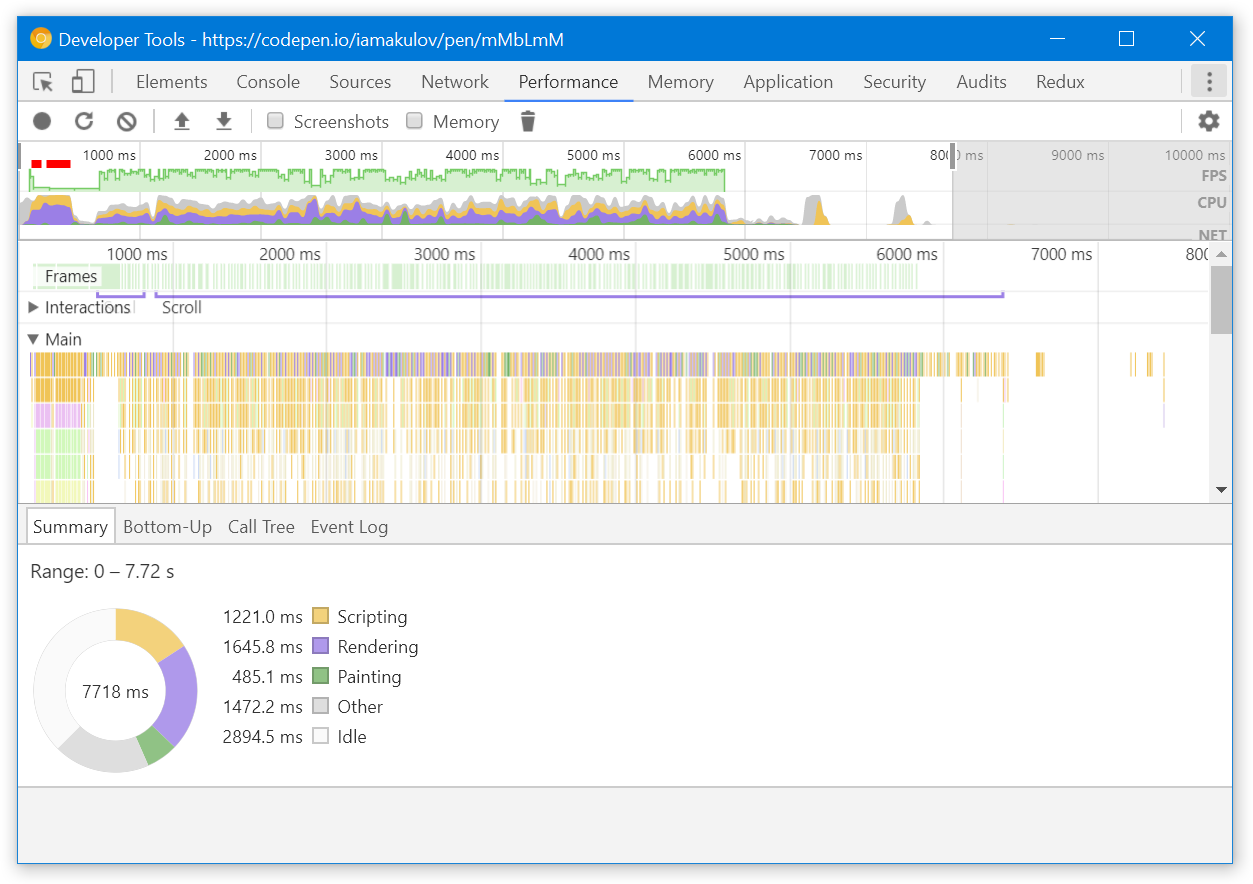If you listen for events like mousewheel, resize or scroll, your page could get slow. These events are generated multiple times per second, and if the event handler takes too much time, the browser won’t catch with redrawing the page.
This is what to do if you have such problem.
Throttle#
By default, the event handler is executed on each event. Sometimes, when the handler is taking a long time, it might be acceptable to delay its execution to once per 100-200 ms. This “delaying” can be achieved with the _.throttle utility method.
When is this useful? E.g. if you recalculate the page layout each time the browser resizes. If recalculating layout takes a long time, you could perform it less often.
Before and after:
// Before
window.addEventListener('resize', () => {
calculateLayout(); // Takes 20 ms
});
// After
window.addEventListener('resize', _.throttle(() => {
calculateLayout(); // Still takes 20 ms, but now runs once in 100 ms
}, 100));
passive: true#
passive: true a flag that’s passed into addEventListener. It tells the browser that the event handler will never call event.preventDefault(). Using this knowledge, the browser can start doing the event action (e.g. scrolling) without waiting for the JS code to finish. This makes the page smoother.
touchstart, touchmove and mousewheel event handlers could be made passive.When is this useful? E.g. if you redraw the parallax background on each touch or scroll event. Most likely, it won’t be a problem if the browser starts scrolling before the background finishes redrawing. If so, such event handler could be made passive.
Before and after:
// Before:
window.addEventListener('touchstart', updateBackground)
// After:
window.addEventListener('touchstart', updateBackground, {
passive: true
})
Use alternative APIs#
For some common tasks, there are alternative APIs that help to perform the task easier and with better performance:
- Intersection Observer. It helps if you need to detect when an element goes off the screen or intersects with another element. This API can replace the
scrollandresizelisteners. window.matchMedia. This API can notify you when a specific media query becomes true. Helps if you need to e.g. update the page layout when the viewport reaches a specific width. It can replace theresizelisteners.position: sticky. This CSS property lets you stick an element to the top when it reaches an edge of the viewport. Helps if you need to e.g. make a sticky page header. It can replace thescrolllisteners that switch the element fromposition: statictoposition: fixedand vice versa.-
At the moment of July 2017, the API is not yet well-supported. However, there’s a polyfill.
Resize Observer. It helps if you need to detect when an element gets resized. This API can replace the
scrollandresizelisteners.Thanks to Vitali Kuzmich for mentioning this approach.
Optimize the code itself#
You can also make the event handler itself run faster. It should take not more than 10 ms to run.
To analyze how much time your handler takes, use Web Performance API or the Performance tab in Chrome DevTools:

The optimization approach depends on your code. Try caching some data or skipping some computations. If you use React, you can try dropping parts of the render tree with shouldComponentUpdate.
And this is what won’t work:#
requestAnimationFrame. It doesn’t help with slow event handlers and, by my tests, doesn’t bring any benefits for fast ones. Seems like it’s only useful for scheduling JS animations.- Event delegation. It optimizes the memory usage, not the speed.
That’s it. Optimize.
How is throttling different than debouncing?
See here: https://stackoverflow.com/questions/25991367/difference-between-throttling-and-debouncing-a-function – or here: https://css-tricks.com/the-difference-between-throttling-and-debouncing/ :–)
In a nutshell:
* Throttling will reduce the number of times the event is fired (e.g. 100ms).
* Debouncing will stop the event from ‘continually firing’ and it will generally either fire once at the beginning OR at the end. The concept behind this comes from electrical push button switches which stops a ripple signal being fired causing interference.
Здравствуйте
Скажите пожалуйста- как вы делаете ссылки рядом с текстом?
Очень нравится)
Хочу так же у себя)
Спасибо